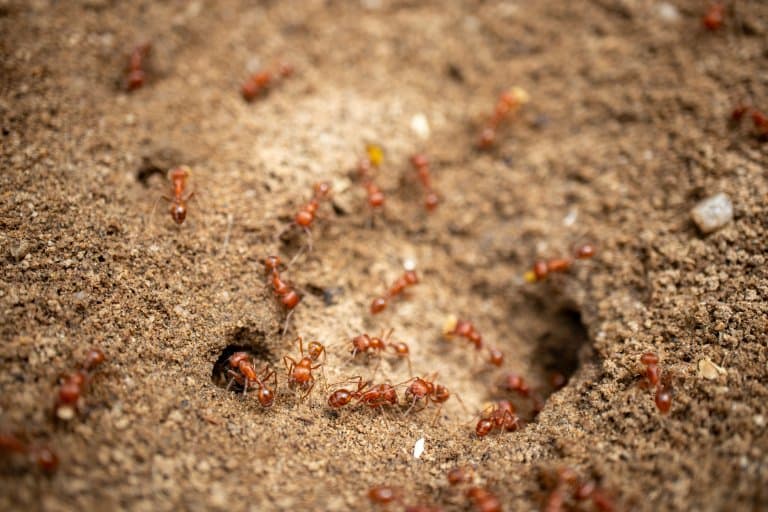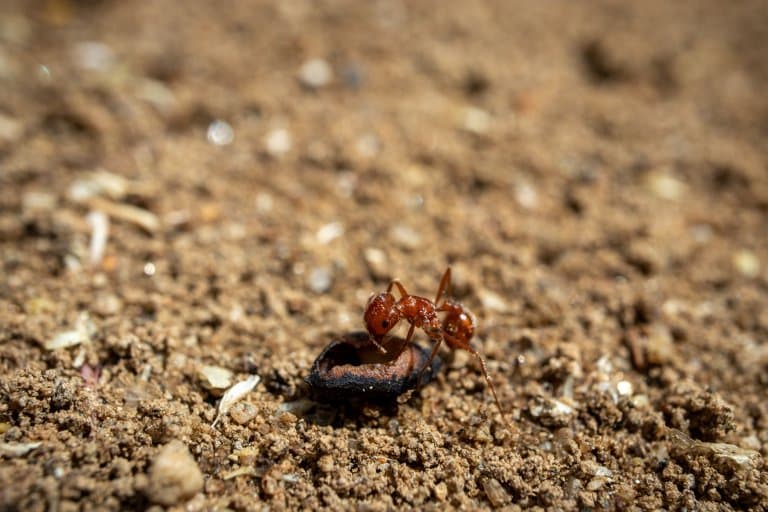Maricopa Harvester Ant Profile
In the arid plains of the US, you may be lucky enough to stumble across a small, subterranean farmer colony, responsible for gathering up seeds and fertilising the surrounding soil.
These little agriculturists are so important to this tough ecosystem that they may be considered a keystone species, and while they don’t hunt, they certainly have the weaponry to defend themselves.
The maricopa harvester ant is one of the most common ant species in the US state of Arizona, and is found from Colorado to Mexico. They are thought to have the most toxic insect venom in the world.

Maricopa Harvester Ant Overview
| Habitat: | Sandy or clay soils, dry and desert environments |
| Location: | Southern Colorado to Mexico |
| Lifespan: | Queens can live upwards of 20 years |
| Size: | Less than 9mm |
| Weight: | >1g |
| Color: | Black head and thorax, orange/brown abdomen |
| Diet: | Seeds, insect forage |
| Predators: | Horned lizards |
| Top Speed: | Slow |
| No. of Species: |
1 |
| Conservation Status: |
Not Listed |
Harvester ants are related to leaf-cutter ants and have similar farming practices.
They’re so good at what they do, and so well-defended, they don’t waste any energy building soldiers. Each worker is equipped with a formidable defence that keeps their territory safe.
They’re not just farmers, either. They’re successful scavengers, builders, and city organisers.
Interesting Maricopa Harvester Ant Facts
1. They’re agriculturalists
Harvester ants are so-called because they collect seeds, and much like their tribemates, the leaf-cutter ants, they do this to grow food for the colony. Seeds make up about half of their forage, and insect parts just over one-third.
But instead of eating their seeds directly, they’re taken into growing chambers inside the colony and allowed to ferment. The resulting fungus is thought to provide the majority of the nutrients for the colony. 1

2. They don’t need soldiers
Most ant colonies have different castes for different needs. Workers, queens and soldiers tend to look totally different from one another and their morphology is suited to their particular jobs.
In the Pogonomyrmex genus, all but one species lacks soldier castes. P. Maricopa has only worker and queen castes.
The queens aren’t much different from the workers, except larger, and the workers play the role of foraging – which they do 25 to 60 meters from the nest – and defending the colony.
So, this little ant species makes do without soldiers, and it does so using a handy little chemical hidden inside its body.
3. Maricopa ants may have the most toxic insect venom in the world
Workers of this species are a formidable opponent to vertebrates. Not only are they aggressive and quick to defend their colony, but they’re also equipped with one of the most toxic – if not the most toxic – venoms in the world.
While field researchers do all the hard work of discovering and describing these ants for a fraction of the pay, their cave-dwelling equivalents are busy in the lab, determining the lethality of insect venoms in the same way they determine much of what we know about the world: by killing rats.
The venom from this ant is 20 times more toxic than a honeybee’s, and the ant employs it after grabbing hold of the skin for leverage and jabbing away with a barbed stinger.
This can detach from the ant’s abdomen and remain in the skin of a vertebrate, and 12 stings are said to be enough to drop a 2kg rat, making it the most toxic insect venom on record.
Lab researchers will no doubt continue to murder rats with insect venom until they find a better one, but for now, Pogonomyrmex Maricopa holds the lead.
It’s likely this venom was designed specifically for protection against vertebrates since they scavenge most of their insect bits and primarily forage seeds.
Still, the amount of venom injected is minimal, and while very painful, this sting isn’t enough to do more than make a person uncomfortable for a few hours. 2
4. They can make cement
This species of ant makes nests in open areas of desert and clears out the top layer of undergrowth for foraging and temperature regulation of the next beneath.
To protect from the seasonal desert winds, they mine calcium carbonate from the soil beneath and, probably in combination with their own secretions, mix it into a strong cement that’s resistant to water and weather damage.
From this, they form protective caps and cover the entrances. Beneath these mounds, the tunnel networks may extend another five meters into the ground. 3
5. They can occupy the same nest for 20yrs
These nests eventually form mounds, which, in some locations, can be two meters tall.
The ants of these megacities clear space for seven meters around the mound for foraging and may spend 20 years in the same location.
The queens can likely live well past this, as some species of harvester ant queens can live for an incredible 50 years, and make similarly-sized megastructures. 4
6. They are well suited to the heat
Most ants like the heat, but these have become accustomed to the intense desert weather. Even other desert species will shuffle home for a siesta when the temperature reaches 40°C, but not these guys.
They’ll forage like mad dogs and Englishmen, happy to continue working in the midday sun, and long after the heat gets too much for their neighbors. 5

7. They create islands of fertility
Harvester ants have been historically considered pests by ranchers who see their clearings as lost ground cover. While they do make these clearings in the grasslands, they seem to provide hotspots of biodiversity on the rims of these clearings.
The ants protect the area from competitors with their powerful reputations, but they also bring fertility to the soil with all the nutrients they bring in.
It’s even been found that they play a role in the rapid recovery of plant life after wildfires. As usual, these seemingly insignificant animals are ecosystem engineers and keystone species; much more significant to the world around them than they let on. 6
Maricopa Harvester Ant Fact-File Summary
Scientific Classification
| Kingdom: | Animalia |
| Phylum: | Arthropoda |
| Class: | Insecta |
| Order: | Hymenoptera |
| Family: | Formicidae |
| Subfamily: | Myrmicinae |
| Genus: | Pogonomyrmex |
| Species: | Pogonomyrmex Maricopa |
Fact Sources & References
- James V. Moody and David E. Foster, “Notes on the Bionomics and Nest Structure of Progonomyrmex Maricopa (Hymenoptera Formicidae)“
- W.L. Meyer (1996), “Most Toxic Insect Venom“, CiteSeerX.
- Walter G. Whitford (2002), “The functional significance of cemented nest caps of the harvester ant, Pogonomyrmex maricopa“, Sci-Hub.
- “Harvester Ant“, Science Direct.
- Roberta (2016), “Ant of the Week: Pogonomyrmex maricopa“, Wild About Ants.
- Derek Uhey (2022), “Heroes, Not Headaches: Reframing the Reputation of Harvester Ants“, Entomology Today.
